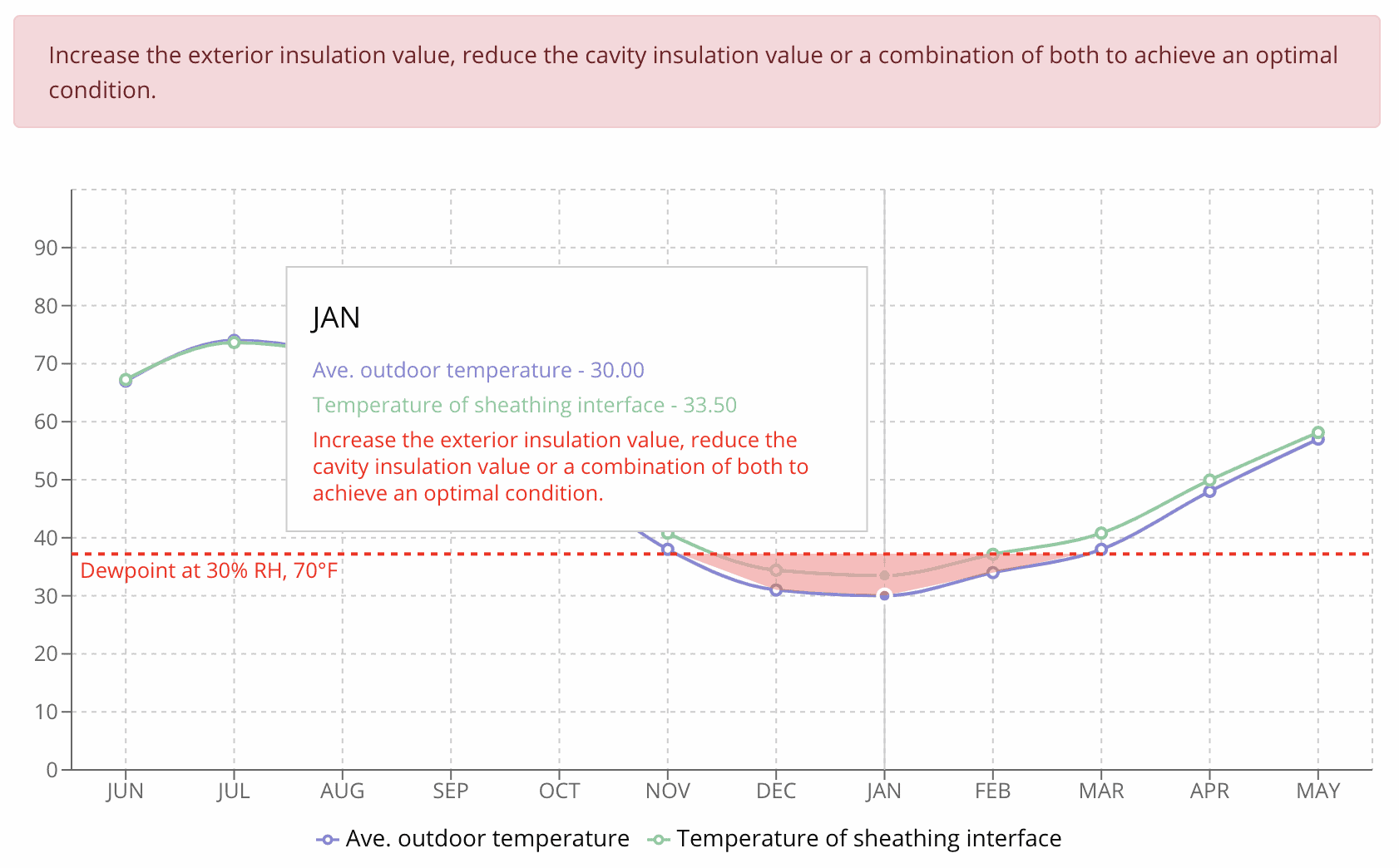Condensation Calculator
-
CONTROLLING WALL CONDENSATION POTENTIAL – SAFER WALLS (EXPAND FOR MORE INFO)
As energy codes get more stringent, adding exterior wall insulation is becoming a reality for more builders. The question then becomes: when does it make sense to add exterior insulation and when can it be skipped?
This example is for a 2×4 wall in climate zone 4*
- The perception: When you insulate a wall, it reduces the heating and cooling costs of a building. It will also (hopefully) make the building more comfortable.
- The reality: Many walls have too little insulation and too many air leaks. This means that warm, moist outdoor air can get in, reach a cool surface, and condense. The result: the surface (usually a wall) gets wet, and mold and mildew begin to grow.
- The data: The sample graph below illustrates when the potential for condensation can occur inside a wall cavity with either no or too little exterior insulation. The dark blue line represents the mean daily temperate in climate zone 5, and the light blue line represents the temperature of the inside surface of the exterior wall sheathing (back side of sheathing). Safe conditions – defined as no danger of condensation forming – are the times when the light blue line is above the pink zone. As we can see, from November through March there is potential for condensation. Nearly one third of the year, moisture could be collecting in the wall cavity, condensing and liquid water could be accumulating in the wall cavity.
Climate Zone 5B – Denver Colorado
R-20 cavity Insulation with no exterior insulation
When warm moist air comes in contact with cold surfaces, condensation occurs — often with very serious consequences. Air leaks from the inside can carry moisture that condenses on the structural sheathing causing an elevated moisture content – and possibly even accumulation of liquid water – that could lead to rot and deterioration. This problem can be avoided by adding exterior insulation in order to keep the wall sheathing warmer than the dew point (the temperature at which water condenses at a particular relative humidity).
As an example, when the inside of a building is heated to 70 degrees F and the air inside is 30% relative humidity on a day when the outside temperature is 30 degrees F, the dew point (the point when moisture vapor condenses into liquid) is 37.2 degrees. So, if that moist air hits a surface that is below 37.2 degrees, the moisture will condense into liquid water. In this example above, we see the condensing surface (Interior of sheathing) is at 33.5 degrees F
This warm, moist air is driven through holes, cracks or gaps in the walls – such as around electrical boxes, under the base of the drywall at the plate, interior partition intersections, etc. – by air pressure differences developed from wind, stack effect, or mechanical equipment. The moist air travels through the gaps, through the permeable insulation materials and through holes and inconsistencies in the exterior air barrier, sometimes condensing on the backside of the sheathing and increasing wood moisture content above a safe level. In some cases, liquid water accumulates in the cavity.
This second sample graph below illustrates the same conditions as the previous slide but with R-5 exterior insulation added to the wall. It is still 70 degrees F, 30% RH inside, with a dewpoint of 37.2 degrees F, and it is still 30 degrees outside:
Climate Zone 5B – Denver Colorado
R-20 cavity Insulation with R-5 exterior insulation
Note that the exterior insulation has increased the temperature of the sheathing to 40.28 F, which is higher than the dew point of 37.2 degrees. This means that the water vapor will not condense inside the wall cavity; it remains suspended in air.
- The solution: increase the R value of your walls by adding a layer of continuous exterior insulation. How much exterior insulation is needed depends on the climate zone in which you live, but the 2012, 2015 and 2018 International Energy Conservation Code has guidelines worth following — especially if your jurisdiction has already adopted it!
- Important note: If condensation control is achieved in your climate zone there are provisions in the International Residential code to change the type of vapor retarder required on the warm, interior side of the wall or in many cases completely omit this application of a vapor retarder.
- The source: Ci Labs, Justin Wilson
*Climate zones matter when considering wall types and insulation strategies. Please don’t take this as a road map for all houses.
Please select the following to generate a result for your location:
- Choose Country
- Choose State (If applicable)
- Choose City
- Choose unit of measurement
- Input cavity wall insulation R-value
- Input exterior wall insulation value
Note that all climate zones and locations have different insulation requirements. Please check your local building codes to make certain your “total effective wall thermal values” are satisfied.




